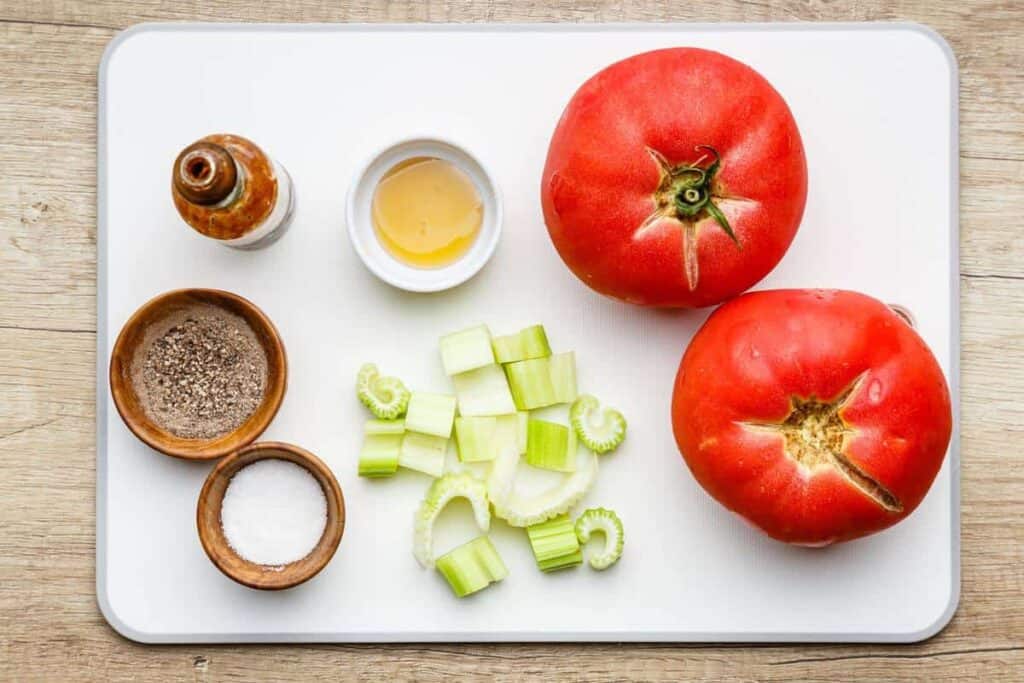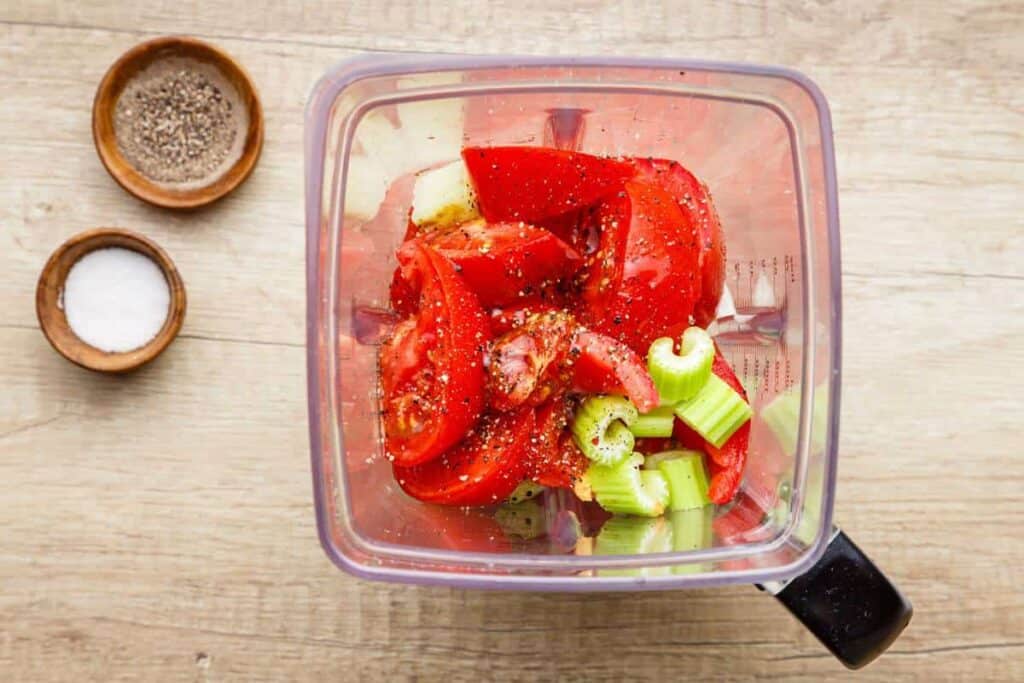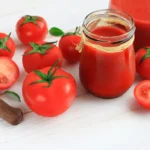Tomato juice is a popular and refreshing beverage enjoyed by many. Not only is it delicious, but it also offers numerous health benefits, as tomatoes are packed with vitamins and antioxidants. It is believed that tomato juice tastes best when it is homemade. But how to make tomato juice in a blender at home? And is it possible to make juice in a blender? Well, making tomato juice at home is not only cost-effective but also allows you to control the ingredients and enjoy a freshly made glass of juice.
However, many people find making tomato juice at home to be a challenging task, as they might not know the right techniques or equipment to use. Additionally, finding fresh, ripe tomatoes can be difficult, especially during the off-season. But the truth is there are many simple ways that you can use to make juice at home in a few simple steps. For that, you need all the essential ingredients and, most importantly, an ideal blender to blend all the ingredients for a fine and smooth texture.
In this article, I will provide a simple and delicious recipe for making tomato juice using a blender. I will also discuss how to choose the best tomatoes for your juice and share some tips for customizing the flavor to your liking.
Tomato Juice
Before you know how to make juice in a blender, let’s discuss the basics of tomato juice!
Tomato juice is a popular beverage made from fresh tomatoes, which are first crushed and then strained to remove the seeds and skin. The resulting liquid is then usually sweetened, salted, and sometimes even flavored with various spices and herbs.

Nutritional Info
| Nutrient | Amount per 100g |
| Calories | 18 |
| Total Fat | 0.2g |
| Saturated Fat | 0g |
| Trans FatF | 0g |
| Cholesterol | 0mg |
| Sodium | 32mg |
| Potassium | 222mg |
| Total Carbohydrate | 4g |
| Dietary Fiber | 1.2g |
3 Reasons Why Homemade Tomato Juice Is Better Than Store-Bought Tomato Juice
Have you ever wondered why homemade tomato juice is often considered superior to store-bought varieties? As someone who has explored the world of tomato juice, I can share my experience and shed light on the reasons why homemade tomato juice surpasses its commercial counterpart.
Here are three compelling reasons:
Freshness and Quality Control
Homemade tomato juice offers complete control over ingredients and freshness, ensuring only the best produce is used. Unlike store-bought juice, which often contains preservatives and additives, homemade juice maintains taste and nutritional value. It also allows for personal flavor adjustments and maintains quality control throughout the process.
Nutritional Value
Homemade tomato juice is a healthier alternative to store-bought varieties due to its minimal processing and high content of vitamins A, C, K, potassium, and lycopene. Unlike commercial juices, which often undergo excessive heat treatment and prolonged storage, homemade juice maintains its nutritional value and provides a wholesome beverage with essential nutrients.
Customization and Versatility
Making homemade tomato juice is a fun and customizable experience, allowing you to experiment with different types of tomatoes and adjust sweetness, acidity, and spiciness to suit your taste. It can also be used in various recipes like soups, sauces, cocktails like bloody mary, or marinades, adding an extra dimension of enjoyment and creativity to your kitchen endeavors.
Tomatoes To Use To Make Tomato Juice
When it comes to making tomato juice, choosing the right type of tomato is crucial to achieve a delicious and flavorful result. After extensive research and personal experience, I have found that four types of tomatoes work exceptionally well for making tomato juice. These varieties not only provide a rich taste but also offer a perfect balance of sweetness and acidity. Let me share my insights on these top choices:

Roma Tomatoes
Roma tomatoes are widely regarded as one of the best options for making tomato juice. Known for their meaty texture and low water content, they produce a thick and flavorful juice. Romas have a slightly sweet taste with a hint of tartness, which adds depth to your juice. Their firm flesh also makes them easy to process and extract juice from. Whether you prefer a smooth or chunky consistency, Roma tomatoes are an excellent choice.
San Marzano Tomatoes
San Marzano tomatoes are renowned for their exceptional flavor and are often considered the gold standard for making tomato-based products. Originating from Italy, these elongated plum tomatoes have dense flesh and fewer seeds, making them ideal for juicing. San Marzano tomatoes possess a rich, sweet taste with low acidity, resulting in a smooth and velvety tomato juice that is simply delightful.
Beefsteak Tomatoes
If you desire robust and full-bodied tomato juice, beefsteak tomatoes are an excellent option. These large-sized tomatoes are known for their juicy flesh and intense flavor profile. With their high water content, beefsteak tomatoes produce a refreshing and thirst-quenching juice that bursts with natural sweetness. They are particularly suitable for those who prefer a lighter and more refreshing tomato juice.
Yellow Tomatoes
For a unique twist on traditional tomato juice, yellow tomatoes can be an exciting choice. These vibrant fruits offer a milder flavor compared to their red counterparts while maintaining the perfect balance of sweetness and acidity. Yellow tomatoes produce a smooth and velvety juice with a subtle tang that is both refreshing and satisfying. If you are looking to experiment with different flavors, yellow tomatoes can provide an interesting alternative.
How To Make Tomato Juice With A Blender?
Moving toward our main topic, let’s discuss how to make tomato juice with a blender in a stepwise manner.
To make tomato juice with a blender, follow these simple steps:
Gather Ingredients and Equipment
To begin, gather the necessary ingredients and equipment. You’ll need:
- Fresh tomatoes (about 1 kg or 2 pounds)
- Salt and pepper, to taste
- Optional: fresh herbs (such as basil or cilantro), garlic, or hot sauce for added flavor
- A blender
- A fine mesh strainer or cheesecloth
- A large bowl
- A funnel
- A bottle or container for storing the tomato juice
Prepare the Tomatoes
Wash the tomatoes thoroughly and remove any stems or leaves. Cut the tomatoes in half and remove any seeds or core. The fewer seeds you have, the smoother your juice will be.

Blend the Tomatoes
Place the tomato halves in the blender. Add a pinch of salt and pepper and any additional herbs or spices you’d like to incorporate. Blend the tomatoes on high until they are completely smooth and have reached a juice-like consistency.

Strain the Juice
Pour the blended tomatoes through a fine mesh strainer or cheesecloth into a large bowl. Use a spatula or the back of a spoon to press the tomatoes against the strainer or cheesecloth, extracting as much juice as possible. Discard the solids that remain in the strainer or cheesecloth.
Transfer the Juice
Using a funnel, carefully pour the strained tomato juice into a clean bottle or container. Seal the container and store the tomato juice in the refrigerator.

Taste and Adjust
Before serving, taste the tomato juice and adjust the seasoning as needed. If the juice is too thick, you can thin it out with a small amount of water.
Best Blenders To Use To Make Homemade Tomato Juice
You might be wondering if you can use any blender to make homemade tomato juice. The answer is no; not all blenders are created equal when it comes to making tomato juice. Some blenders are better suited for this task than others, and choosing the right one can make all the difference in the quality of your juice.
Here are three of the best blenders to use to make homemade tomato juice:

Vitamix 7500 Blender
The Vitamix 7500 Blender is a powerful and versatile blender that can easily handle the task of making tomato juice. Its high-performance motor and robust blades ensure that even the toughest tomato skins are broken down, releasing all the juice and flavor. The Vitamix 7500 also has a variety of speed settings, allowing you to control the texture of your tomato juice, whether you prefer it smooth or slightly chunky.
Blendtec Classic 570 Blender
Another great option for making homemade tomato juice is the Blendtec Classic 570 Blender. This blender boasts a powerful motor and sharp blades that can easily crush and blend tomatoes, extracting maximum juice and flavor. The Blendtec Classic 570 also offers a variety of pre-programmed cycles, which can be useful for making tomato juice, as they help ensure the right consistency and texture.
Breville Boss Kitchen Machine
The Breville Boss Kitchen Machine is a high-quality blender that is perfect for making homemade tomato juice. This blender features a powerful motor and sharp blades that can easily crush and blend tomatoes for maximum juice extraction. Additionally, the Breville Boss Kitchen Machine comes with a variety of attachments, including a juicer attachment, which can be helpful for making tomato juice.
3 Signs That Your Tomato Juice Is Starting To Go Bad
Now that you have made tomato juice at home, it is important to know when it starts to go bad. As an experienced juice enthusiast, I can share with you three signs that indicate your tomato juice is starting to spoil. Paying attention to these signs will help ensure that you consume fresh and safe tomato juice.
Change in Color and Texture
One of the first signs that your tomato juice is going bad is a noticeable change in its color and texture. Fresh tomato juice has a vibrant red color and a smooth, liquid consistency. However, as it begins to spoil, the color may darken or become dull. Additionally, you may observe the formation of lumps or clumps in the juice, indicating the presence of bacteria or mold growth. If you notice any significant changes in color or texture, it is best to discard the juice.
Foul Odor
Another clear indication that your tomato juice is no longer suitable for consumption is a foul odor. Fresh tomato juice has a pleasant aroma reminiscent of ripe tomatoes. However, as it spoils, the smell will become unpleasant and sour. If you detect an off-putting odor when opening the bottle or container of tomato juice, it is a strong indication that it has gone bad and should not be consumed.
Sour or Taste
The taste of your tomato juice can also reveal its freshness. When freshly made, tomato juice has a slightly tangy and sweet flavor. However, if it starts to spoil, the taste will become sour or off. This change in taste occurs due to the growth of bacteria or yeast in the juice. If you take a sip and notice an unusual or unpleasant taste, it is best to avoid consuming any more of the tomato juice.
How To Store Tomato Juice?
Storing tomato juice properly is essential to maintain its freshness and flavor. Follow these steps to ensure that your tomato juice stays delicious and safe to consume:
Chill the juice immediately.
After opening a can or bottle of tomato juice, it is important to store it in the refrigerator to prevent bacterial growth. Transfer the juice to a clean, airtight container and place it in the fridge. This will help to preserve the taste and quality of the juice for a longer period.
Use an airtight container
Using an airtight container when storing tomato juice will prevent air from entering and causing spoilage. For storing or for canning, glass containers are a great option, as they are non-porous and do not affect the taste of the juice.
Consume within a week
Tomato juice, once opened, should be consumed within a week. After this time, the flavor and quality of the juice may begin to degrade. To extend the shelf life of your tomato juice, consider freezing any leftovers in small, portion-sized containers.
Avoid exposure to light
Exposure to light can cause the vitamins and nutrients in tomato juice to break down over time. To prevent this, store the juice in an opaque or dark-colored container and keep it in the refrigerator or a cool, dark place.
Check for spoilage
Before consuming any stored tomato juice, check for signs of spoilage such as off-odors, mold, or a change in color. If any of these signs are present, it is best to discard the juice and open a fresh container.
Conclusion
In summary, making tomato juice in a blender is a simple and convenient process that allows you to make a delicious and refreshing drink right at home. By following the steps outlined in this article, you can easily prepare fresh and healthy tomato juice using just a few basic ingredients and a blender. This homemade tomato juice not only tastes great but also offers numerous health benefits, making it a perfect addition to your daily diet.
FAQs
How Do You Make Tomato Juice In A Blender?
To make tomato juice in a blender, blend fresh tomatoes until smooth, then strain the mixture to remove seeds and pulp.
Can I Make Juice In My Blender?
Yes, you can make juice in your blender by blending desired fruits or vegetables until smooth and then straining if necessary.
What’s The Easiest Way To Can Tomato Juice?
The easiest way to make tomato juice involves simmering fresh tomato juice with added seasonings and then processing it in sterilized jars using a water bath canner.
Can I Freeze Homemade Tomato Juice?
Yes, you can freeze homemade tomato juice by pouring it into freezer-safe containers, leaving some space for expansion, and storing it in the freezer.
How To Store Tomato Juice For Later?
To store tomato juice for later, refrigerate it in a sealed container for up to a week or freeze it for longer storage.
What Can You Do With Leftover Tomato Juice?
Leftover tomato juice can be used in soups, sauces, cocktails, or as a base for marinades and dressings.

Rebecca Wojcik
Rebecca Wojcik, a highly skilled and accomplished nutrition expert, is an experienced Registered Dietitian Nutritionist, Registered Yoga Teacher (200 hr), and successful female entrepreneur.






